E P A shown below in Runic form

EPA Type 10
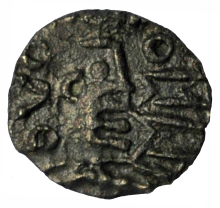
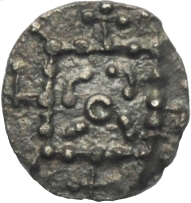
TMS 16/57
Die Axis on this coin is 90º hence oblong apperance
This type has the runes EPA reading in a clockwise direction from the top of the coin downwards, the top of the runes point towards the outside of the flan. It has the rectangular nose/forehead very typical of the R8 series. On many of the specimens the runes have some degree of distortion and are sometimes not properly formed as with the middle rune in the image above. This group has a typical Reverse of a beaded standard of usually between seventeen and twenty-nine beads, this standard contains a central plain annulet. There are two L’s adjacent to each other and two 45° lines adjacent to each other. Each corner has a line pointing out from the corner, mostly from the corner bead, at 45°, the line ending in a pellet. Mid-point along each side is a cross pommée pointing outwards at 90°. I refer to this style as a typical LOLII R8 standard. The artwork frequently extends over the flan edge.
Type Ten consisted of thirteen coins with ID numbers 7,13, 19, 39, 40, 41, 45, 51, 52, 56, 57, 68 and 71. Five coins came from Norfolk, 39 no weight; 40 = 1.15g; 41 = 1.01g; 45 no weight; 56 = 0.99g. Four were of unknown origin, 13 = 1.01g; 19 = 0.65g; 52 = 1.01g and 71 = 0.87g. One was found in Cambridgeshire 51 = 0.68g; one in Suffolk 57 = 0.79g one in Lincolnshire 68 = 0.86g and one in Leicestershire 7 = 1.03g. Average weight of eleven type Ten coins (two no weight given) 0.913g.
The above coin, TMS 16/57 has many similarilies on both the obverse and reverse with coins EMC 2001.0008 (ID 40) and 2002.0248 (ID 41)
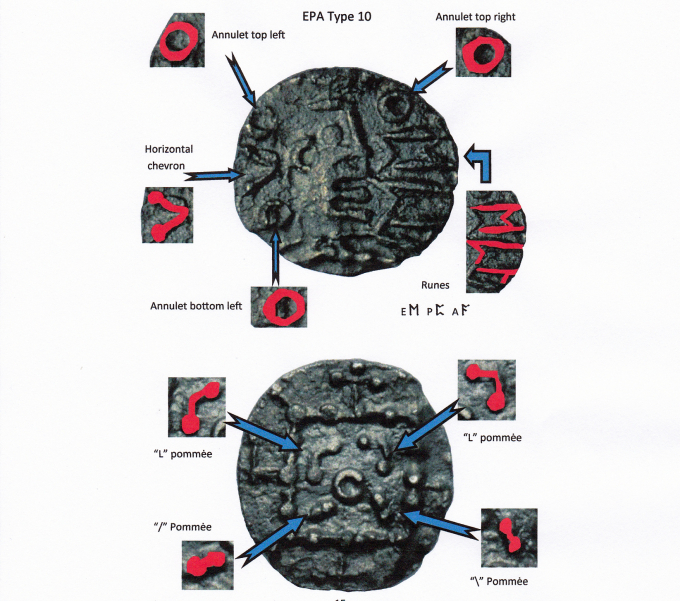
TMS 16/57
EPA Type 12
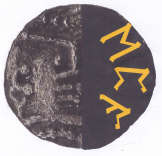
Image only shows position of Runes. See image 661 Plate 28 in Gannon, A. 2013. Sylloge of Coins of the British Isles 63 British Museum Anglo-Saxon Coins 1, British Museum Press
This type has the runes EPA reading in a clockwise direction from the top of the coin downwards, the top of the runes point towards the outside of the flan. It has the rectangular nose/forehead very typical of the R8 series with the exception of a pellet within the horizontal chevron behind the head. The reverse is a typical LOLII with the exception of a Tufa or Fantail on top of the standard not the usual cross. The one coin in this type, ID 11, was found in Suffolk and weighed 0.94g.
EPA Type 13
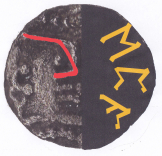
Image only shows position of Runes. See image number 1999.0108 Early Medieval Corpus on-line database at the Fitzwilliam Museum Cambridge.
This type has the runes EPA reading in a clockwise direction, the top of the runes point towards the outside of the flan. It has a pointed nose un-typical of the R8. The three-pointed crown on the head is fully visible. The reverse is a typical LOLII. The one coin in this type, ID 38, with no find spot available weighed 0.95g.
EPA Type 14
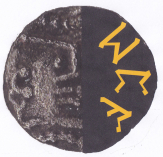
Image only shows position of Runes. See image number 1993.9415 Early Medieval Corpus on-line database at the Fitzwilliam Museum Cambridge.
This type has the runes pointing part inwards and part outwards. The E rune top is pointing inwards, the P rune is outwards and the A is pointing outwards. The nose on the obverse is pointed. The reverse has a typical LOLII configuration. The one coin, ID 33, was found in Leicestershire and weighed 1.13g.
A further coin of this type has been discovered, EMC 2019.0392. It weighs 0.91g and has a die axis of 135°. It is slightly ovoid in shape measuring 11.5 x 12.5mm. It was found near Hilton in Cambridgeshire. It is shown below.
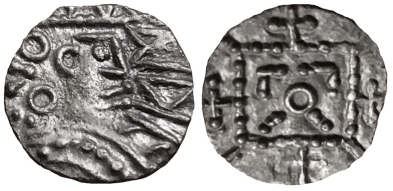
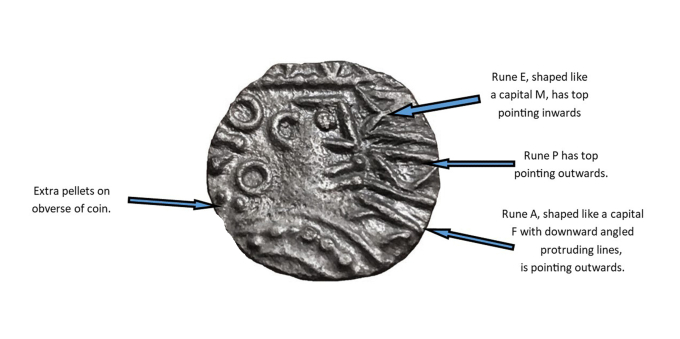

The image left shows the P rune on the right side of the coin.
In the above diagram the rune P is described as pointing outwards. It can be difficult to interpret the way a “P” rune’s top is pointing. If the vertical line is behind the other elements of the character (reading left to right) the top of the character is pointing upwards. As the runes on the obverse are cut around the outside of the die/flan they are in an almost vertical position on the coin. This is sometimes further complicated by the runes being depicted in a retrograde format reading in an anti-clockwise way! The runes are often stylised, imagine cutting a die for a coin on a similar size flan to a modern 5p with the tools available in Anglo-Saxon England around 740 AD. Die cutters did not usually have the expertise, skills or equipment of the Anglo-Saxon jewelry makers, some probably could not read or write.
EPA Type 15
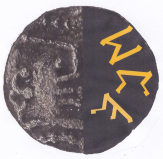
Image only shows position of Runes. See image 662 Plate 28 in Gannon, A. 2013. Sylloge of Coins of the British Isles 63 British Museum Anglo-Saxon Coins 1, British Museum Press
The runes have their tops pointing inwards/outwards/inwards, top of E facing into the centre of the coin with the runes being read clockwise. It is very uncommon to see runes written like this in the R8 series. It has a pointed nose on the face. The reverse is a typical LOLII. The one coin of this type, ID 12, was found in Essex and weighed 1.19g.
A further coin of this variety has been observed . This is only the second example of this type I have seen.The Obverse was very similar to 662 above. The coin was found at Boston in Lincolnshire, EMC 2019.0009, it was not included in the initial survey.
In 2021 I purchased another coin of this variety, 2021.0219, see below.
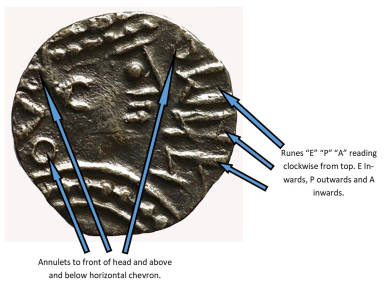
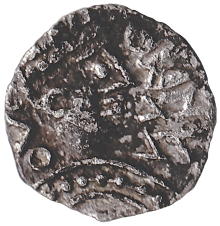
The coin pictured left, 2012.0219, is a Type 15, it is possible that this coin is a Die Match with 2019.0009 above.
EPA Type 16
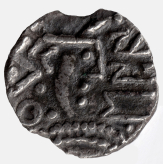
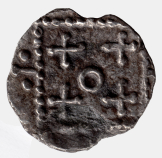
EMC 2016.0321
This Type has the runes with tops pointing inwards, top of M pointing into the centre of the coin with the runes being anti-clockwise. It is very uncommon to see runes written like this in the R8 series. It has a slightly pointed nose on the face.
The one coin in this class ID 69 was found in Norfolk and weighed 0.62g. Metcalf has classified the coin as a "Contemporary Copy", an R8/E3 "mule". The reverse belongs to a Porcupine of variety F. Metcalf & Op den Velde 2009-10 cat no 3228-3436.
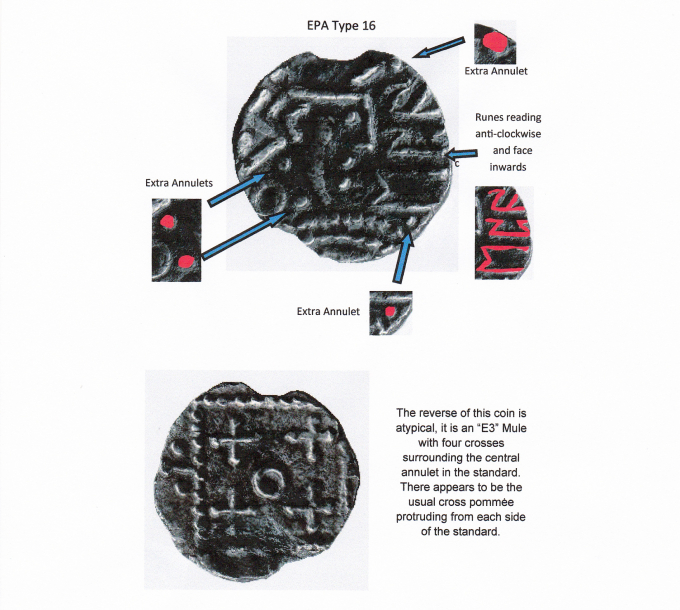
I have purchased yet another coin of Type 16. This is only the third coin of this type that I have ever seen. Below are pictures of the coins. I have not been able to register one coin with the EMC as the Find Spot is unknown.
The Obverse shows the remarkable similarity between both the runes and symbols behind the head. Are these coins a die match? The Reverse has very similar "unbarred" crosses outside the Standard. The Standard is offset to one side. This coin was not included in the original survey.
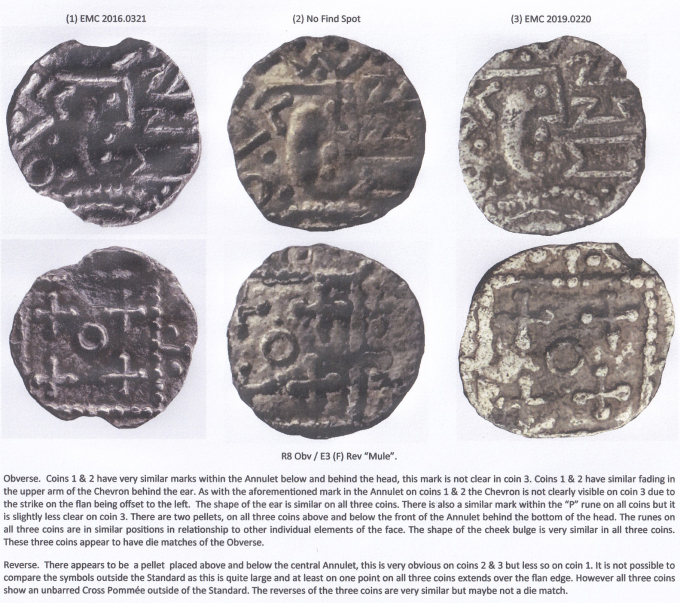
Coin weights are:-
Coin 2016.0321 - 0.62g, found Thetford, Norfolk.
Coin (No find spot) - !.06g,
Coin 2019.0220 - 0.89g, found Clipstone Nottinghamshire.
Further discussion about the Type 16 iconography can be seen on the British Numismatic Society (BNS) Blog
https://britnumsoc.blog/2019/10/26/unusual-iconography-on-three-r8-sceatta-c-timms/
EPA Type 18
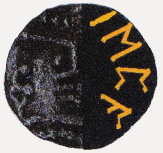
Image only shows position of Runes. See image 673 Plate 29 in Gannon, A. 2013. Sylloge of Coins of the British Isles 63 British Museum Anglo-Saxon Coins 1, British Museum Press
The obverse of this type has an unidentified rune in front of the ‘E’. The runes are read clockwise and the tops point outwards. The nose is of the more usual rectangular shape. On the reverse the standard has annulets in place of crosses on each of the four sides. There is a pellet on each side of the annulets. Of the two coins in this type, one ID 21 was found in Suffolk and weighed 0.67g and the other find spot was not known, ID 22, weighed 0.75g.
The coin pictured below was purchased after the initial survey. As above this coin also has an unidentified rune/character.before the E rune.
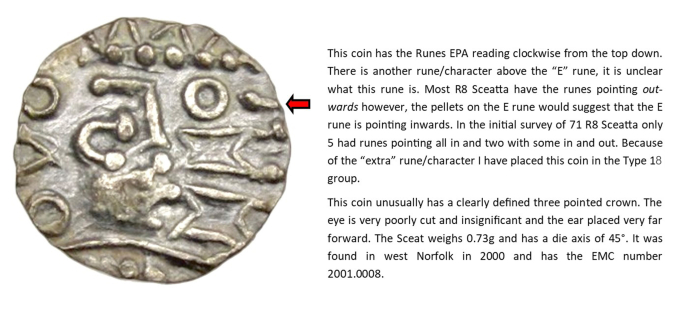
EPA/EAP Type 19
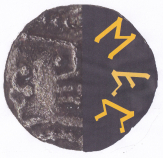
Image only shows position of Runes. See image 677 Plate 29 in Gannon, A. 2013. Sylloge of Coins of the British Isles 63 British Museum Anglo-Saxon Coins 1, British Museum Press
This coin appears to have the unusual runic combination of EAP, this is the only coin I have seen with this runic combination. The runes read in a clockwise direction, they are pointing part inwards and part outwards. The E points outwards and the A points inwards. The P appears to point outwards. The head/nose is rectangular in shape, typical of many R8 obverses, however there seem to be other symbols present also. The standard on the reverse contains two L’s, one angled line and what looks like one T on its side surrounding the central annulet. This single coin, ID 25, came from Suffolk and weighed 0.72g.




